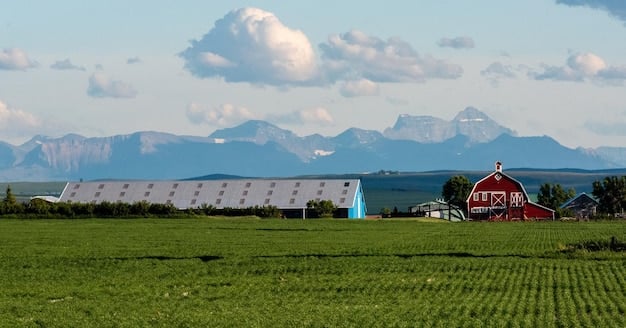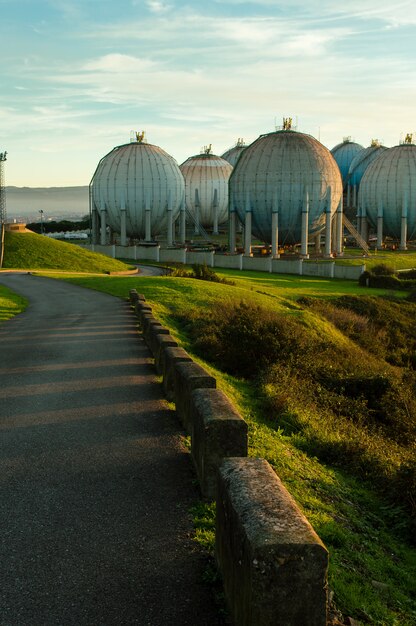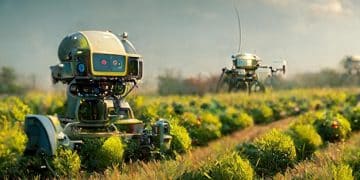US Farm Bill Update: Shaping Sustainable Agriculture Market Trends

The updated US Farm Bill is poised to significantly impact sustainable agriculture market trends by influencing funding, research, and policy related to conservation, renewable energy, and local food systems.
The next iteration of the US Farm Bill is on the horizon, and its implications for the burgeoning sustainable agriculture market are substantial. How will the updated US Farm Bill impact sustainable agriculture market trends? Let’s delve into the key areas that will shape the future of farming in the United States.
Understanding the US Farm Bill and Its Significance
The US Farm Bill is a comprehensive piece of legislation that is renewed approximately every five years. It governs an array of agricultural and food programs, impacting everything from crop insurance to nutrition assistance. Understanding its structure and funding mechanisms is crucial to grasping its potential effects on sustainable agriculture.
Key Areas Covered by the Farm Bill
The Farm Bill addresses various titles or sections, each focusing on a specific aspect of agriculture and food policy. These include:
- Commodities: Supports commodity crop production through subsidies and price supports.
- Conservation: Funds programs that encourage farmers to adopt environmentally friendly practices.
- Nutrition: Provides funding for food assistance programs like SNAP (Supplemental Nutrition Assistance Program).
- Crop Insurance: Offers insurance products to protect farmers against losses due to weather or market fluctuations.
Funding Mechanisms and Policy Levers
The Farm Bill’s funding is allocated through mandatory and discretionary spending. Mandatory spending is allocated automatically based on existing laws, while discretionary spending is subject to annual appropriations. Policy levers within the bill can incentivize sustainable practices through financial assistance, research grants, and regulatory changes.
In conclusion, the US Farm Bill is a pivotal piece of legislation that significantly influences agricultural practices and food security nationwide. Its comprehensive nature and funding mechanisms hold the potential to reshape the future of sustainable agriculture.

Current Trends in Sustainable Agriculture
Sustainable agriculture is gaining momentum, driven by consumer demand, environmental concerns, and a growing recognition of the long-term benefits of eco-friendly farming practices. Several key trends are shaping this sector, indicating a shift towards more responsible and resilient agricultural systems.
Growing Consumer Demand for Sustainable Products
Consumers are increasingly seeking out products that are sustainably produced, with certifications like organic and Fair Trade influencing their purchasing decisions. This demand is spurring innovation and market growth for sustainable agriculture.
Technological Innovations in Sustainable Farming
Advancements in technology are playing a crucial role in enhancing sustainable farming practices. Examples include:
- Precision Agriculture: Using data and sensors to optimize inputs and reduce waste.
- Vertical Farming: Growing crops in stacked layers indoors to minimize land use and water consumption.
- Regenerative Agriculture: Implementing practices that rebuild soil health and sequester carbon.
Policy and Regulatory Frameworks Supporting Sustainability
Governments and regulatory bodies are increasingly implementing policies that promote sustainable agriculture. These include incentives for adopting conservation practices, restrictions on harmful pesticides, and support for local food systems.
To summarize, the sustainable agriculture market is experiencing significant growth, fueled by escalating consumer demand, revolutionary technological innovations, and supportive policy frameworks that are collectively steering the agricultural industry toward a more ecologically sound and economically viable future.
Potential Impacts of the Updated Farm Bill on Conservation Programs
The Conservation Title within the Farm Bill is instrumental in supporting farmers who adopt environmentally friendly practices. Updates to this title can have profound effects on the adoption of sustainable agriculture practices across the US.
Enhancements to the Environmental Quality Incentives Program (EQIP)
EQIP provides financial and technical assistance to farmers who implement conservation practices. Potential enhancements could include increased funding, streamlined application processes, and a greater emphasis on climate-smart agriculture.
Changes to the Conservation Stewardship Program (CSP)
CSP rewards farmers who actively manage and improve existing conservation efforts on their land. Updates to CSP could focus on incentivizing more advanced practices and promoting long-term stewardship.
Impact on Land Management and Soil Health
Effective conservation programs can lead to:
- Improved Soil Health: Reducing erosion, increasing organic matter, and enhancing water infiltration.
- Reduced Water Pollution: Minimizing runoff of fertilizers and pesticides.
- Enhanced Biodiversity: Creating habitats for wildlife and pollinators.
In summary, strategic updates to the Conservation Title within the Farm Bill could significantly amplify the reach and efficacy of programs like EQIP and CSP, resulting in enhanced land management practices, improved soil health, and a more resilient agricultural landscape.
Renewable Energy and the Farm Bill: Opportunities for Sustainable Agriculture
The Farm Bill also supports renewable energy development in rural areas, creating opportunities for farmers to diversify their income and reduce their carbon footprint. Updates to these provisions can further integrate sustainable agriculture with renewable energy production.
Bioenergy Programs and Their Role
Bioenergy programs, such as the Rural Energy for America Program (REAP), provide grants and loans for renewable energy projects. These programs can help farmers invest in:
- Solar Panels: Generating electricity to power farm operations.
- Biogas Digesters: Converting organic waste into biogas for heating and electricity.
- Wind Turbines: Harnessing wind energy to supplement farm energy needs.
The Farm Bill as a Catalyst for Renewable Energy Adoption
By providing financial incentives and technical assistance, the Farm Bill can encourage farmers to adopt renewable energy technologies, reducing their reliance on fossil fuels and promoting energy independence.
To conclude, integrating renewable energy initiatives into the Farm Bill presents a significant opportunity to foster sustainable agriculture practices, enabling farmers to diversify their income streams, diminish their carbon footprint, and contribute to a more sustainable energy future.

Local and Regional Food Systems: How the Farm Bill Can Help
Support for local and regional food systems is another critical aspect of the Farm Bill. These provisions aim to strengthen local economies, increase access to fresh, healthy food, and promote sustainable farming practices tailored to specific regions.
Funding for Farmers Markets and Local Food Infrastructure
The Farm Bill provides funding for programs like the Farmers Market and Local Food Promotion Program (FMLFPP), which supports:
- Farmers Markets: Providing venues for farmers to sell directly to consumers.
- Food Hubs: Aggregating, distributing, and marketing local food products.
- Community-Supported Agriculture (CSA) Programs: Connecting consumers directly with local farms.
Supporting Small and Mid-Sized Farms
The Farm Bill can also support small and mid-sized farms by providing:
- Access to Credit: Offering loans and loan guarantees to help farmers start or expand their operations.
- Technical Assistance: Providing training and guidance on sustainable farming practices.
- Research and Development: Funding research on crops and techniques that are well-suited to local conditions.
Enhancing Food Security and Community Resilience
Investing in local and regional food systems can:
- Improve Food Access: Ensuring that all members of the community have access to fresh, healthy food.
- Strengthen Local Economies: Creating jobs and supporting local businesses.
- Enhance Community Resilience: Reducing reliance on long-distance supply chains that can be vulnerable to disruptions.
In summary, strengthening local and regional food systems through strategic provisions in the Farm Bill fosters vibrant community growth, enhances small and mid-sized farm viability, andbolsters overall food security and resilience.
Challenges and Opportunities in Implementing the Updated Farm Bill
While the updated Farm Bill offers significant opportunities to advance sustainable agriculture, there are also challenges to its effective implementation. Overcoming these challenges is essential to realizing the bill’s full potential.
Political and Economic Factors Influencing the Bill’s Passage
The Farm Bill is often subject to intense political debate, with competing interests vying for funding and policy priorities. Economic conditions, such as commodity prices and budget constraints, can also influence the bill’s scope and direction.
Ensuring Equitable Access to Programs and Resources
It is crucial to ensure that all farmers, including those from historically underserved communities, have equal access to Farm Bill programs and resources. This may require targeted outreach efforts, technical assistance, and simplified application processes.
Measuring and Evaluating the Impact of Sustainable Agriculture Initiatives
Developing robust metrics and evaluation frameworks is essential to assess the effectiveness of sustainable agriculture initiatives funded by the Farm Bill. This will help policymakers make informed decisions about future investments and policy adjustments.
To summarize, while the updated Farm Bill presents numerous opportunities to propel sustainable agriculture forward, addressing political and economic factors, ensuring equitable access to programs, and measuring the impact of initiatives are vital steps to overcome implementation challenges and maximize the bill’s potential benefits.
| Key Aspect | Brief Description |
|---|---|
| 🌱 Conservation Programs | Funding for practices that improve soil, water, and habitat quality. |
| ⚡ Renewable Energy | Incentives for farmers to adopt on-farm renewable energy systems. |
| 🍎 Local Food Systems | Support for farmers markets, food hubs, and community-supported agriculture. |
| 📊 Research & Innovation | Funding for sustainable agriculture research and development initiatives. |
FAQ
▼
The US Farm Bill is a comprehensive package of legislation passed every five years that has a wide-ranging impact on agriculture, food, and rural communities. It covers everything from crop insurance to nutrition assistance programs.
▼
The Farm Bill influences sustainable agriculture through conservation programs, renewable energy initiatives, and support for local food systems. These provisions can help farmers adopt more environmentally friendly practices.
▼
Key conservation programs include the Environmental Quality Incentives Program (EQIP) and the Conservation Stewardship Program (CSP). These programs provide financial and technical assistance to farmers who implement conservation practices.
▼
The Farm Bill supports local food systems through programs like the Farmers Market and Local Food Promotion Program (FMLFPP), which funds farmers markets, food hubs, and community-supported agriculture programs.
▼
Challenges include political and economic factors, ensuring equitable access to programs, and measuring the impact of sustainable agriculture initiatives. Overcoming these challenges is crucial for realizing the bill’s full potential.
Conclusion
The updated US Farm Bill holds significant potential to reshape sustainable agriculture market trends. By strategically allocating resources and implementing supportive policies, this legislation can drive positive change, fostering a more resilient, environmentally friendly, and economically viable agricultural sector.





